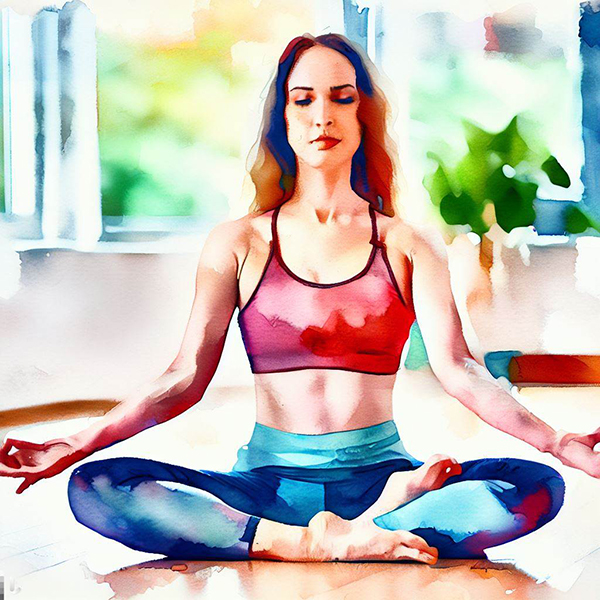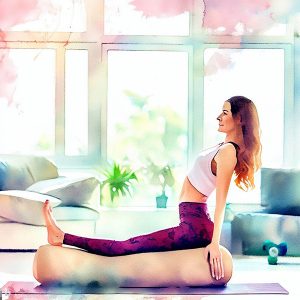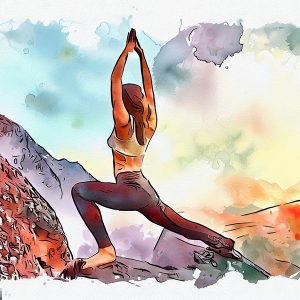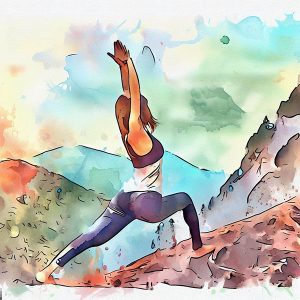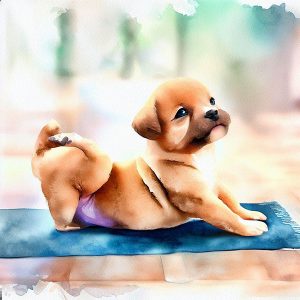The yoga wheel, a versatile and innovative prop, has gained immense popularity for its ability to deepen yoga practice, improve flexibility, and offer therapeutic benefits.
Flexibility and Strength with the Yoga Wheel: Your Comprehensive Guide
In this article, we delve into the origins, benefits, proper usage, and considerations associated with the yoga wheel. Whether you’re a seasoned yogi or a beginner, this guide aims to provide you with insights to incorporate the yoga wheel into your practice effectively.
Origins and Purpose: Originally inspired by the ancient yoga prop called the “chakrasana wheel,” the modern yoga wheel is designed to assist practitioners in achieving more advanced poses, enhance flexibility, and provide support during stretches and backbends. Its circular shape and supportive padding create a bridge between traditional yoga postures and contemporary alignment techniques.
Benefits of Using the Yoga Wheel:
- Improved Flexibility: The yoga wheel enables gradual and safe stretching, helping to increase flexibility in the spine, shoulders, hips, and hamstrings.
- Enhanced Backbends: The wheel’s curvature allows practitioners to access deeper backbends while providing support to the spine.
- Core Strength: Incorporating the yoga wheel into poses engages the core muscles, promoting stability and balance.
- Alignment Assistance: The wheel aids in proper alignment, preventing strain and injury during complex poses.
- Stress Relief: Gentle stretches using the wheel can alleviate tension and stress accumulated in the body.
Effective Ways to Use the Yoga Wheel:
- Spinal Stretch: Lie on the wheel with your spine aligned, allowing it to contour your back and gently stretch the entire length of your spine.
- Deepen Backbends: Place the wheel under your mid-back during poses like bridge or camel pose to support and amplify your backbend.
- Hip Opener: Sit on the wheel and lean back, using it to gently open your hip flexors and release tension.
- Arm Balances: Place your hands on the wheel during arm balance poses to engage core stability and support.
Considerations and Precautions:
- Beginner Friendly: While suitable for beginners, gradual progression is advised to avoid overstretching.
- Injuries and Limitations: Individuals with spinal injuries, neck issues, or other medical conditions should consult a healthcare professional before using the wheel.
- Quality Matters: Invest in a high-quality yoga wheel with proper padding and dimensions to ensure safety and durability.
Elevate Your Practice with the Yoga Wheel The yoga wheel adds a new dimension to your yoga journey, facilitating deeper stretches, enhanced flexibility, and improved alignment. By incorporating it mindfully and seeking guidance when needed, practitioners of all levels can experience its transformative benefits. Whether you’re looking to refine your backbends, amplify core engagement, or simply enjoy therapeutic stretches, the yoga wheel is a valuable tool that can enhance your overall yoga experience.
Benefits of Using the Yoga Wheel: Enhance Your Yoga Practice
- Improved Flexibility: The yoga wheel aids in gentle yet effective stretching, helping increase flexibility in the spine, shoulders, and hips.
- Deepened Backbends: By providing support and extension, the wheel allows for safer and more profound backbend poses, promoting spinal health.
- Enhanced Core Strength: Integrating the wheel in poses engages core muscles, enhancing stability and balance during practice.
- Proper Alignment: The wheel assists in maintaining proper alignment in various poses, reducing the risk of strain or injury.
- Therapeutic Stretching: Utilize the wheel to release tension and stress, promoting relaxation and mental well-being.
- Increased Mobility: Regular use of the wheel can help increase joint mobility, especially in areas prone to stiffness.
- Versatile Prop: The yoga wheel is versatile and can be used for a variety of poses, from backbends to hip openers and inversions.
- Progressive Practice: Beginners can gradually incorporate the wheel to gradually deepen poses, enhancing their practice over time.
- Mind-Body Connection: By aiding in alignment and support, the wheel encourages practitioners to connect more deeply with their bodies.
- Posture Correction: The wheel encourages proper posture awareness, which can carry over into daily life, promoting better posture habits.
Note: Incorporating the yoga wheel into your practice can lead to a more well-rounded and dynamic yoga journey, offering physical, mental, and emotional benefits.
Testimonials about Yoga Wheel
- Floyd Sheppard
“As a yoga enthusiast, I was initially skeptical about the yoga wheel, but after trying it, I’m a believer! The wheel’s support in backbends and hip openers has allowed me to progress in my practice with confidence. I appreciate how it gently stretches my spine and helps me achieve better alignment. It’s not just a prop; it’s become an integral part of my practice, and I can’t imagine my yoga routine without it!”
- Conrad Russo
Raise Your Yoga Practice and Quality of Life with the Yoga Wheel
Are you ready to experience a new dimension of yoga practice that enhances flexibility, strength, and overall well-being? The yoga wheel offers a gateway to deeper stretches, improved alignment, and therapeutic benefits. Here’s how you can take action:
1. Embrace Exploration: Integrate the yoga wheel into your practice to explore new poses, deepen stretches, and enhance your yoga journey.
2. Mindful Progression: Start slowly and mindfully, gradually incorporating the wheel to experience its transformative benefits without pushing your limits.
3. Seek Guidance: Whether you’re a beginner or an experienced yogi, consider seeking guidance from teachers or online resources to ensure safe and effective usage.
4. Listen to Your Body: Pay attention to your body’s cues and adjust the intensity of your practice accordingly, making the most of the yoga wheel’s support.
5. Elevate Your Well-Being: By incorporating the yoga wheel into your practice, you’re investing in your physical health, mental clarity, and emotional balance.
6. Share Your Journey: Share your experiences with the yoga wheel with friends, family, and fellow yogis, inspiring them to explore its benefits too.
Transform Your Practice with the Yoga Wheel The yoga wheel isn’t just a prop; it’s a tool that can enhance your yoga practice and elevate your quality of life. With dedication, mindfulness, and the right guidance, you can unlock new dimensions of flexibility, strength, and alignment. Begin your journey today and witness the positive impact of the yoga wheel on your overall well-being. Your practice, your body, and your life deserve this transformative addition.
Possible Concerns, Limitations, and Considerations for Using the Yoga Wheel:
- Physical Limitations: Individuals with existing back issues, spinal injuries, or chronic conditions should exercise caution and consult a healthcare professional before using the yoga wheel.
- Injury Risk: Incorrect use or overexertion with the yoga wheel can lead to strain, discomfort, or even injury, especially if practitioners attempt advanced poses without proper guidance.
- Beginner Caution: While beneficial, beginners should approach the yoga wheel with care and gradually ease into its usage to avoid overstretching or strain.
- Neck and Spine Alignment: Misalignment during backbends or stretches with the wheel can cause discomfort or injury, emphasizing the importance of proper guidance.
- Quality Matters: Poorly constructed or low-quality yoga wheels may not provide adequate support and comfort, potentially leading to discomfort or instability.
- Personalized Guidance: Each body is unique, and what works for one person might not work for another. Consulting a yoga instructor or physical therapist can provide personalized recommendations.
Importance of Consulting a Health Professional:
- Pre-existing Conditions: Consulting a healthcare professional is crucial if you have any pre-existing health conditions, injuries, or physical limitations that might affect your ability to use the yoga wheel safely.
- Guidance for Beginners: Beginners should consider taking classes or seeking guidance from a yoga instructor to ensure proper technique and avoid potential strain.
- Injury Prevention: Healthcare professionals can provide insights on using the yoga wheel to prevent injuries and address specific concerns based on individual health history.
Prioritize Safety and Expert Guidance While the yoga wheel offers numerous benefits, it’s essential to approach its usage with caution, especially if you have specific health concerns or physical limitations (Wikipedia). Consulting a healthcare professional or experienced yoga instructor can help you navigate any potential limitations and ensure that you’re using the yoga wheel safely and effectively. Remember, your safety and well-being always come first.
Questions and Answers about: Yoga Wheel
What is a yoga wheel? A yoga wheel is a circular prop designed to assist yoga practitioners in enhancing their practice. It offers support, stretches, and aids in achieving poses that might be challenging otherwise.
How does a yoga wheel work? The yoga wheel’s circular shape supports the spine, offers stability, and encourages safe backbends and stretches. It assists in deepening stretches, improving flexibility, and promoting proper alignment.
Who can benefit from using a yoga wheel? Practitioners of all levels can benefit from the yoga wheel. It’s particularly valuable for those looking to improve flexibility, deepen poses, or enhance core strength. However, individuals with specific injuries or conditions should consult a professional before use.
What poses can be practiced with a yoga wheel? Yoga wheels can be used for various poses, including backbends, hip openers, stretches, and even arm balances. It offers support in achieving more advanced poses while promoting alignment.
Can beginners use a yoga wheel? Yes, beginners can use a yoga wheel, but it’s recommended to start with simpler poses and gradually progress. Proper guidance from instructors or online resources can help ensure safe usage.
How do I choose the right yoga wheel? Look for a yoga wheel with proper padding, suitable dimensions, and a weight capacity that accommodates your needs. Quality and durability are essential factors to consider when choosing a yoga wheel.

